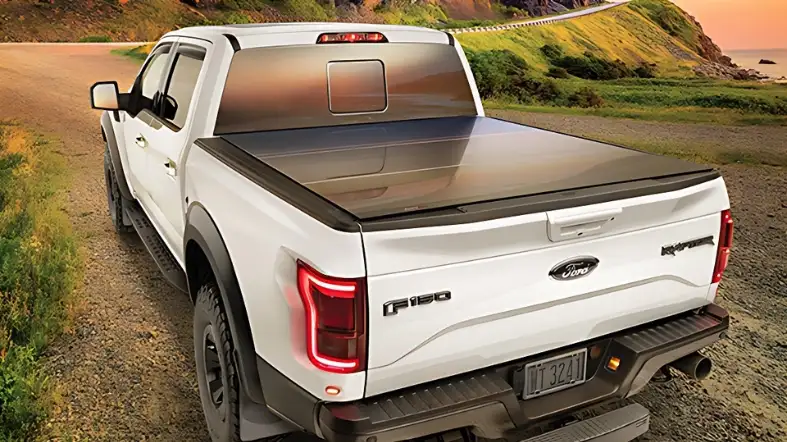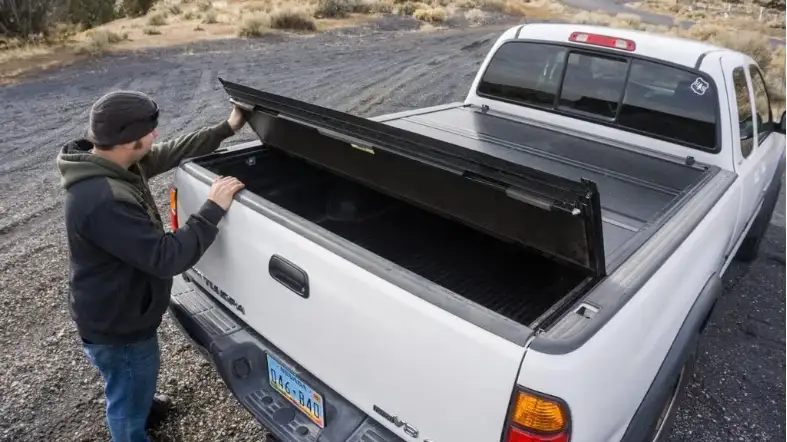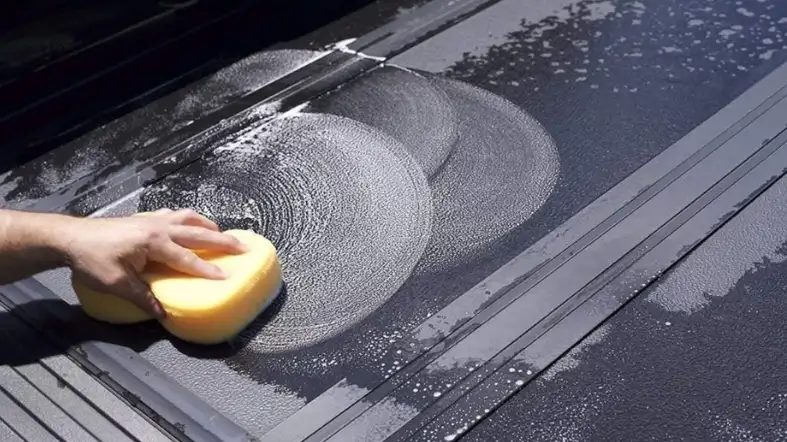How long does it take to put on a tonneau cover? If you’re a truck owner looking to protect your cargo and enhance the functionality of your vehicle, this question might have crossed your mind.
Installing a tonneau cover can offer numerous benefits, but the time required for the installation process may vary.
In this article, we’ll explore the factors that influence the time it takes to put on a tonneau cover and provide you with a step-by-step guide for a hassle-free installation.

How long does it take to put on a tonneau cover?
The time it takes to put on a tonneau cover varies depending on the type and installation method. On average, it can take anywhere from 15 to 30 minutes for a straightforward installation.
However, factors like experience, cover design, and truck model can influence the duration.
Step-by-Step Guide: Installing a Tonneau Cover
A roll-up tonneau cover is a popular choice due to its simplicity and versatility. Follow these steps to install a roll-up tonneau cover on your truck:
Unbox and Lay Out the Cover
Begin by unboxing the tonneau cover and laying it out flat near your truck bed.
Ensure that all the necessary components, such as rails, clamps, and hardware, are present and in good condition.
Position the Side Rails
Next, position the side rails along the sides of your truck bed, making sure they align with the front and back edges.
Adjust the rails as needed to ensure a proper fit. Some tonneau covers may require drilling holes for the rails, so refer to the manufacturer’s instructions for specific guidelines.
Secure the Side Rails
Using the provided clamps or mounting hardware, secure the side rails to the truck bed. Tighten the clamps or bolts firmly to hold the rails in place.
Double-check the alignment and make any necessary adjustments before proceeding.
Attach the Cover to the Side Rails
With the side rails securely fastened, attach the tonneau cover to the rails according to the manufacturer’s instructions.
Typically, this involves sliding the cover into the rails and securing it using latches or Velcro straps. Ensure that the cover is centered and properly aligned on the bed.
Test the Operation
Once the tonneau cover is attached, carefully roll it up or retract it according to the specific mechanism of your cover.
Ensure that it operates smoothly and locks securely in place when closed. Make any necessary adjustments to the tension or alignment to achieve optimal functionality.
Factors Affecting the Installation Time of a Tonneau Cover

While these factors can influence the installation time of a tonneau cover, it’s essential to prioritize accuracy and safety over speed:
Type of Tonneau Cover
The type of tonneau cover you choose can significantly impact the installation time.
Different types, such as roll-up covers, folding covers, retractable covers, and hinged covers, have varying installation procedures.
Some covers may require more complex installation steps, including drilling or modifying your truck bed, which can increase the overall installation time.
Experience and Skill Level
Your experience and skill level with installing tonneau covers also play a role in the time it takes to complete the installation.
If you have prior experience or are familiar with the specific tonneau cover model you’re installing, you’ll likely be able to work more efficiently and complete the installation faster.
However, if you’re a novice or attempting the installation for the first time, it may take longer as you familiarize yourself with the process.
Tools and Equipment
Having the right tools and equipment readily available can significantly impact the installation time.
Before you begin, ensure you have all the necessary tools, such as wrenches, screwdrivers, and drills, as specified by the tonneau cover manufacturer.
Having to search for or improvise tools can cause unnecessary delays and prolong the installation process.
Truck Bed Condition
The condition of your truck bed can affect the ease and speed of tonneau cover installation.
If your truck bed is clean, free of debris, and has no existing bed rail caps or track systems that need modification, the installation process will likely be smoother and quicker.
However, if your truck bed requires cleaning or modifications, additional time will be needed to prepare the bed before installing the tonneau cover.
Instructions and Support
The clarity and comprehensiveness of the manufacturer’s installation instructions can impact the installation time.
If the instructions are well-written, easy to follow, and accompanied by illustrations or videos, you’ll be able to proceed more quickly.
On the other hand, unclear or incomplete instructions may lead to confusion and require additional time for troubleshooting or seeking assistance.
Assistance and Support
Installing a tonneau cover can often be a two-person job. Having an extra set of hands to help position and secure the cover can significantly reduce the installation time.
If you have a friend or family member available to assist you, it can make the process smoother and more efficient.
However, if you’re working alone, you may need to allocate additional time for tasks that would be easier with assistance.
Maintaining and Cleaning Your Tonneau Cover

To keep your tonneau cover in optimal condition and ensure its longevity, regular maintenance, and cleaning are essential.
By following these steps, you can effectively maintain and clean your tonneau cover, regardless of whether it is a soft or hard cover.
Inspect Regularly
Begin by inspecting your tonneau cover regularly for any signs of damage, wear, or debris accumulation.
Check for tears, loose fasteners, or bent components. Addressing any issues promptly will help prevent further damage and maintain the cover’s functionality.
Clean Soft Tonneau Covers
For soft tonneau covers, follow these steps to clean them properly:
Remove Loose Debris
Start by removing any loose dirt, leaves, or debris from the cover’s surface. Use a soft-bristle brush or a handheld broom to gently sweep off the debris.
Clean Hard Tonneau Covers
Cleaning hard tonneau covers requires a slightly different approach. Follow these steps for effective cleaning:
Remove Loose Debris
Use a soft-bristle brush or a handheld broom to remove any loose dirt, leaves, or debris from the cover’s surface.
Gently sweep across the cover, paying attention to hard-to-reach areas.
Prepare Cleaning Solution
In a bucket, mix a mild detergent or soap with warm water. Ensure that the detergent is suitable for the cover’s material, such as fiberglass or aluminum.
Wash the Cover
Dip a sponge or soft cloth into the cleaning solution and gently scrub the hard tonneau cover.
Focus on removing any stains, grime, or sticky substances. Avoid using abrasive scrubbers or brushes that can scratch the surface.
Rinse Thoroughly
After cleaning, rinse the tonneau cover thoroughly with clean water. Use a hose or a bucket of water to ensure that all the detergent is washed away.
Dry the Cover
Wipe the cover’s surface with a clean, dry cloth to remove excess water. Pay attention to any corners or crevices where water might accumulate.
Allow the cover to air dry completely before closing it or exposing it to direct sunlight.
Lubricate Moving Parts
If your tonneau cover has moving parts, such as hinges or latches, it’s important to lubricate them periodically.
Apply a silicone-based lubricant or a manufacturer-recommended lubricant to ensure smooth operation and prevent rust or corrosion.
Protect Against UV Rays
To protect your tonneau cover from the damaging effects of UV rays, consider applying a UV-protectant product.
These products help prevent fading, cracking, and deterioration caused by prolonged sun exposure.
Follow the manufacturer’s instructions for application and reapplication intervals.
Can You Measure a Truck Bed for a Tonneau Cover Before Putting It On?
Before putting on a tonneau cover, measuring the truck bed is crucial to ensure a proper fit. By accurately measuring the dimensions, you can determine the right size cover needed for your truck. This process, known as measuring truck bed for cover, helps you avoid any compatibility issues and ensures a secure and aesthetically pleasing installation.
FAQs
Can I Install A Tonneau Cover By Myself, Or Do I Need Help?
Most tonneau covers can be installed by one person, but having a helper can make the process easier and faster, especially for larger or heavier covers.
Are There Any Tools Required For Tonneau Cover Installation?
The tools needed for tonneau cover installation vary depending on the cover type and manufacturer.
Generally, basic hand tools like a wrench or screwdriver are sufficient.
Consult the manufacturer’s instructions for specific tool requirements.
Can I Remove A Tonneau Cover Easily If Needed?
Yes, tonneau covers are designed to be easily removable when necessary.
They typically feature quick-release mechanisms or clamps that allow for convenient removal or reinstallation.
How Long Does It Take To Remove A Tonneau Cover?
Removing a tonneau cover is generally quicker than installation and can take approximately 10 to 15 minutes, depending on the cover type and your familiarity with the process.
Final Words
Transform your truck in no time with a tonneau cover installation! In just 30 minutes to 1 hour, you can have your cover securely in place.
Whether you prefer to tackle it alone or with a friend, the process is manageable and rewarding.
With basic tools and following the manufacturer’s instructions, you’ll enjoy the benefits of a tonneau cover in a jiffy.
Get ready to hit the road with style and protection!
